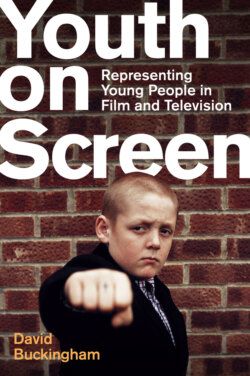Youth on Screen

Реклама. ООО «ЛитРес», ИНН: 7719571260.
Оглавление
David Buckingham. Youth on Screen
Table of Contents
Guide
Pages
Youth on Screen: Representing Young People in Film and Television
Copyright page
Acknowledgements
1 Introduction
Troubling ‘youth’ and ‘screens’
Aims and focus of the book
Representing age
Notes
2 Troubling Teenagers: How Movies Constructed the Juvenile Delinquent
Constructing delinquency
Delinquency and the movies
Screening delinquency
Debating juvenile delinquency: the UK
Violent Playground
Conclusion
Notes
3 Dreamboats, Boybands and the Perils of Showbiz: The Rise and Fall of the Pop Film
Beyond the binaries
Elvis on film, 1956–8
Cliff Richard: a clean teen?
Constructing ‘The Beatles’
Catch Us If You Can
The Monkees in Head
Conclusion
Notes
4 Reeling in the Years: Retrospect and Nostalgia in Movies about Youth
American Graffiti
Badlands
Travelling in time
Peggy Sue Got Married
Pleasantville
Dazed and Confused: beyond nostalgia
Everybody Wants Some!!
Conclusion
Notes
5 Gender Trouble: Cinema and the Mystery of Adolescent Girlhood
Adolescence, girlhood and the Gothic
Picnic at Hanging Rock
Heavenly Creatures
The Virgin Suicides
The Falling
The Fits
Conclusion
Notes
6 This is England: Growing Up in Thatcher’s Britain
Looking back to the 1980s
Growing up on telly
Representation: art cinema and social realism
Representing class
Conclusion
Notes
7 Skins and the Impossibility of Youth Television
The impossibility of ‘youth television’?
Looking yonder
The trouble with authenticity
Youth at the centre
Beyond moralizing
Realism, comedy and melodrama
Managing the formula
Exploiting ‘interactivity’
Managing fandom
Conclusion
Notes
8 Conclusion: Histories and Futures
Reading history from film and television
How film and television read history
‘Coming of age’ as history
Media histories, media futures
Conclusion
Notes
Further Reading
TV and Filmography
References
Index
POLITY END USER LICENSE AGREEMENT
Отрывок из книги
DAVID BUCKINGHAM
I would again like to thank my editors at Polity, Mary Savigar, Ellen MacDonald-Kramer and John B. Thompson, for their continuing encouragement and careful support.
.....
The policeman is interrupted before he can finish, but the onus is clearly placed on dedicated teachers to take the place of parents. The issue is not so much poverty as the failure of the family.
If Blackboard Jungle refuses any explanation based on social class (these things happen on ‘both sides of the tracks’), it does explore the question of race. One of Dadier’s first moves in attempting to win the control of his class is to seek the support of Gregory Miller. If Artie West is the ‘bad delinquent’, who ultimately proves to be beyond redemption, Miller is the ‘good delinquent’, who can be saved. Being black, Dadier tells him, is not an excuse for failing in school; and, right at the end of the film, Miller responds to Dadier’s encouragement by agreeing to stay on at school for a further year. However, Dadier runs into trouble when he uses racial slurs in an attempt to counter the prejudice and abuse he sees happening among his class and receives a strong lecture from the school principal. Although he is not guilty in this case, he later gets into a confrontation with Miller and unthinkingly calls him ‘You black –’, only to be consumed with remorse. In a particularly striking scene, we see him watching Miller and his black friends as they sing a version of the spiritual ‘Go Down Moses’ in preparation for the school’s Christmas concert. Significantly, Miller urges them not to syncopate (or ‘jazz up’) the melody, implying the need for a ‘respectable’ version of African-American culture. In all these respects, the film’s treatment of race is decidedly liberal, although it needs to be understood in its time: the Brown v. Board of Education decision that ended racial segregation in US schools took place the year before the film’s release and was still being massively resisted in many Southern states.
.....